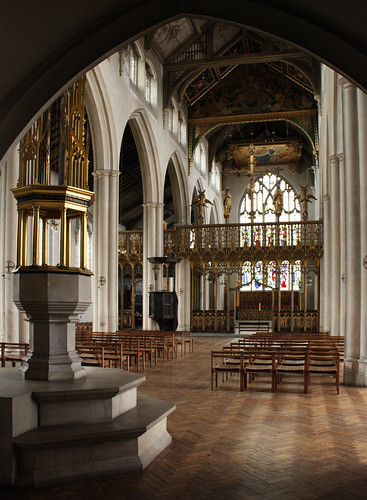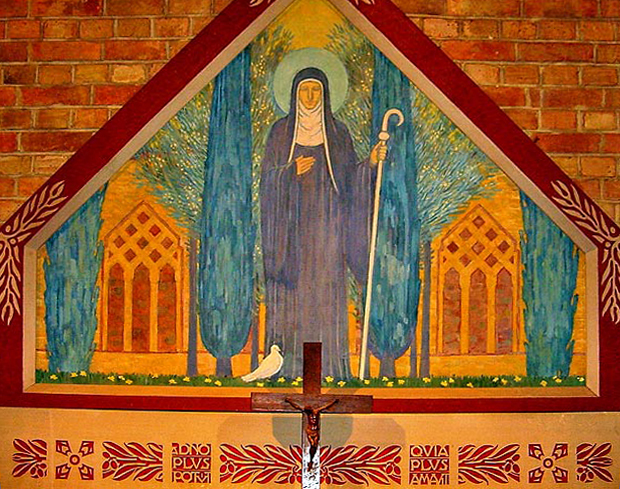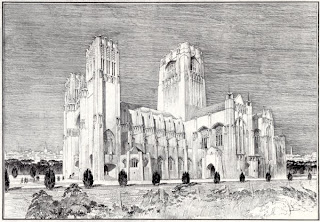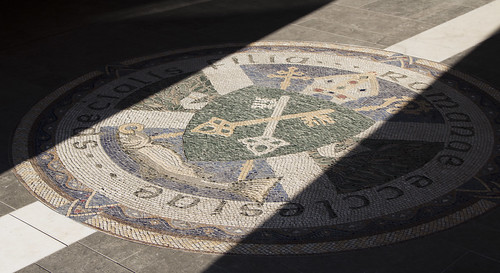![Arms of the Archdiocese of Glasgow]()
The See of Glasgow traces its roots to St Kentigern, who died c.614, but it wasn't until 1175 that Pope Alexander III granted the See of Glasgow the title of 'filia specialis Romanæ ecclesiæ', "special daughter of the Roman church", which gave it full independence from the Archdiocese of York. In 1472, Glasgow was elevated to the status of a Metropolitan See with its own Archbishop. The Reformation, of course, interrupted the life of the Catholic Church in Glasgow and pastoral oversight was only re-established in 1827 with the establishment of vicariates in Scotland. This was because the Catholic population had ballooned with the influx of immigrants from Ireland, Italy, Germany, Holland, Belgium, Lithuania, and Poland at this time, which continued into the 20th century. So, in 1878 Pope Leo XIII restored the Scottish hierarchy.
Back around 1114, when Bishop John was appointed by the pope as the first pre-Reformation Bishop of Glasgow, a new cathedral had been built for him by King David. But there was no such largess when the diocese was re-established in the 19th-century. Hence, St Andrew's church by the river Clyde was pressed into service as the new cathedral church.
![St Andrew's Cathedral in Glasgow]()
St Andrew's church had been built in 1814 to accommodate the 3000 Catholics who flocked to rented premises in the city for Mass each Sunday. Constructed to an early Gothic Revival design by James Gillespie Graham, the church was completed in December 1816 at a cost of £13,000 (around £9.5 million today). It was the first Catholic church built in the city after the Reformation, and thus, the mother church of the new diocese. It is noteworthy that the building pre-dates the influence of A. W. N. Pugin on the Gothic Revival, and his influential ideas on true principles of Christian architecture. Peter Anson notes that "when at last the chapel was completed it was proclaimed to be the most magnificent Papist place of worship in the whole of Britain"! In 1847, shortly after Pugin wrote his treatises on Gothic architecture, the church was described in a local journal as "one of the finest ecclesiastical edifices in the city". In 1889 (when the Cathedral chapter was established) and in 1904 choir stalls and internal screens and side-altars were added by the firm of Pugin & Pugin. Sadly little of this is now evident.
Mindful that Glasgow did not have a purpose-built cathedral, the incumbent Archbishop, Mario Conti, decided that the 200-year-old church should be made "worthy of its purpose" through an extensive restoration project that included practicalities such as heating, new wiring, a sound system, and lighting. Work commenced in 2009 and was completed in April 2011, at a cost of £4.5 million, funded mainly by donations and the selling off of "unused property". I have not been able to find old photographs of the cathedral, but by all accounts the building had become dark and "drab". The result of the two-year restoration is a building that is bright and colourful. Architectural details such as the bosses and capitals have been accentuated by polychrome decoration, the stained glass (reckoned to be the among the first post-Reformation stained glass to be installed in Glasgow) have been cleaned, and over 3000 books of gold leaf have been used to gild the building.
![Inside Glasgow's Catholic Cathedral]()
![Glasgow Cathedral Apse]()
The Archbishop has overseen much of this work, and the fact that the plaster Gothic columns have been painted to look like stone and given polychrome decoration is down to his influence. Archbishop Conti designed the key liturgical furnishings himself. He says: "I wanted [the new altar] to be more substantial than the original, and drew the design on the back on an envelope". This was subsequently executed in marble by Neil Reid, and the altar is inscribed with the words of St Andrew at his martyrdom:
Salva me Bona Crux (Save me, O Good Cross). The Archbishop also designed the lectern, which is inscribed with the Archdiocesan motto,
‘Floreat Praeconio Verbi’, (May it [Glasgow] Flourish by the Proclamation of the Word).
The font used to be placed against a pillar, and thus was obscured. Wishing to give it more prominence, the Archbishop commissioned a font carved from Carrara marble that now stands near the glass narthex doors which are engraved with the heraldic arms of recent Popes, and of recent Archbishops of Glasgow. Designed by Hamilton-born sculptor Tim Pomeroy, the rim of the bowl of the font is carved in low relief with Biblical scenes centred around the Baptism of Christ. A white marble path in the floor of the cathedral leads the eye from the font to the marble altar. As Archbishop Conti explains: “The intention here was to focus on the progression of the spiritual journey, and to draw the eye immediately upwards to the altar... It is like a theology lesson in architecture”.
![Polychrome Details]()
![Glasgow Cathedral Font]()
![Glasgow Cathedral Altar]()
New images of the saints have also been commissioned, such as a painting of the martyrdom of St John Ogilvie, Scotland's only Reformation martyr, who was killed in 1615 at the Glasgow Cross. The painting forms a gilded backdrop to the tabernacle in the Blessed Sacrament aisle, so that all who gather in faith to pray here will be reminded of the fidelity of the martyrs. A set of bronze processional doors with images of Scottish saints has also been commissioned, although they were not yet in place when I visited the cathedral. A 19th-century statue of the Virgin and Child in its Gothic canopy has been retained, but it is flanked by representations of angels created in 2011 by Jack Sloan; an interesting juxtaposition of old and new art.
And this kind of juxtaposition, I suppose, sums up one's experience of the cathedral. There is a celebration of the neo-Gothic building, and the appeal to medieval polychrome, as well as the use of medieval Latin texts, whether inscribed on the furnishings or picked out in gold on the walls. For example, the 'Ave Verum Corpus' runs the entire length of the north wall, leading from the entrance to the tabernacle. But at the same time, this is clearly a 21st-century building (with modern technology in place), and modern artworks and furnishings sit confidently, but not too incongruously, in the church. I think this is right, when we consider how many medieval churches in England accumulate art and furnishings from each generation that has worshipped in it, thus giving to each church a certain eclectic charm and character. I am particularly impressed by the care and thought that has gone into the newly-commissioned pieces, including a mosaic of the Archdiocesan arms in the narthex floor, made with coloured stones from the Holy Land and crafted by Bethlehem Christians; a mark of solidarity with the beleaguered Church in the Holy Land. The rest of the new work has utilised the talents and skills of local artists, which is so necessary if we are to encourage a new pedagogy of sacred art, and form artists in the service of beauty and the Truth.
![Blessed Sacrament Aisle]()
![Regina Angelorum]()
It is perhaps inevitable that bishops should wish for cathedrals to focus on the cathedra, and thus place it in the apsidal apex of the building. Of course, this is not without historical precedent and draws its inspiration from the great basilicas of Rome. However, recent efforts have not always been successful. I think the cathedra here, thankfully, does not detract too much from the altar, but I think more can be done, again, drawing from historical precedence, to emphasise the altar. As the NLM has advocated several times, a
ciborium magnum over the altar would be ideal, and this cathedral seems especially suited to such a structure. A more prominent Crucifix would also be a welcome addition, in my opinion. Although the Crucifixion is depicted in stained glass in the apse, a sculptural piece, either in the blank space behind the cathedra or hanging from an altar canopy, would be most fitting. But, perhaps such additions should be left to the next generation... But for now, there is much to admire in this cathedral restoration, and I was especially edified to see how well-loved and well-used it is – I have seldom seen a church of this size so full for a 1pm weekday Mass.
![Pointed Arches]()
So, may the Church in Glasgow flourish by the preaching of the Word in this cathedral church, and indeed, by the preaching that beauty and sacred architecture give.
More photos of the building can be found
here, and a guide and video may be viewed on the Archdiocese's website
here.
![]()
 Back in 2008, the NLM published this essay by Fr Aidan Nichols OP on the "Archi-Liturgical Culture Wars". Readers of the NLM may thus be interested to learn that this essay has now been published as part of a larger collection of essays by Fr Aidan on Liturgy and the Arts, entitled 'Lost in Wonder'. The book is available here, and the cover illustration (shown on the right) is of the interior of St Cyprian's church by Sir Ninian Comper.
Back in 2008, the NLM published this essay by Fr Aidan Nichols OP on the "Archi-Liturgical Culture Wars". Readers of the NLM may thus be interested to learn that this essay has now been published as part of a larger collection of essays by Fr Aidan on Liturgy and the Arts, entitled 'Lost in Wonder'. The book is available here, and the cover illustration (shown on the right) is of the interior of St Cyprian's church by Sir Ninian Comper.





.jpg)

























































